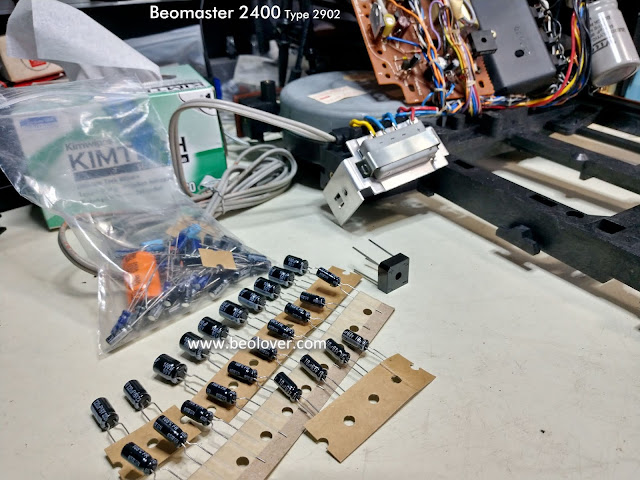I got through all of the work replacing old capacitors in the Beomaster 2400 main board (over 60 capacitors) and volume control board (2 capacitors).
Here is the Beomaster 2400 again prior to replacing the electrolytic capacitors.
This restoration was different than my usual Beomaster 2400 capacitor restorations.
The owner of this Beomaster had already purchased a Beomaster 2400 recapping kit from Martin Olsen. It has been a long time since I used someone's capacitor kit but why not? The capacitors are good capacitors so I wouldn't want to waste them.
This kit has all of the replacement capacitors for the Beomaster 2400 electrolytic capacitors except the two large 5000uF, 50V reservoir capacitors so I will add those two.
The kit also does not contain replacements for the Beomaster 2400 tantalum capacitors. The tantalum capacitors are typically still okay but I normally replace them as the restored audio component often has a long trip back to its owner. Replacing them is a bit of additional insurance to avoid having to send a problem component back and forth.
Here is the Beomaster 2400 after the recapping task of the main board and volume control board have been completed.
For my own knowledge base I always take a little extra time and measure each capacitor I remove. I just want to know what state it is actually in. On this Beomaster 2400 all of the electrolytic capacitors except the large ones were out of tolerance. The 1uF capacitors almost all measured over 2uF. The 2.2uF capacitors were either at 3.5uF or just over 4uF. The 4.7uf were around 6uF.
The tantalums were all still within their 20% tolerances but a lot of them were close to the upper limit.
The reservoir capacitors measured good but I still always replace them to insure against future problems.
Here are the two reservoir capacitors before replacing them.
I joined two terminal posts together for the ground wires and soldered all of the ground wires to that ground terminal. I soldered the positive DC voltage wires to another terminal then soldered that to the positive post of the reservoir capacitor assembly. I also connected the negative DC voltage wires to a terminal on the negative post.
That makes for a really solid reservoir capacitor assembly and the wires are neatly connected.











No comments:
Post a Comment
Comments and suggestions are welcome!